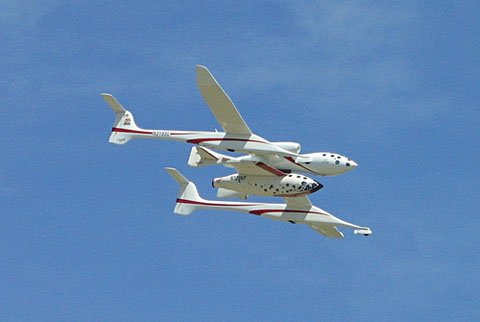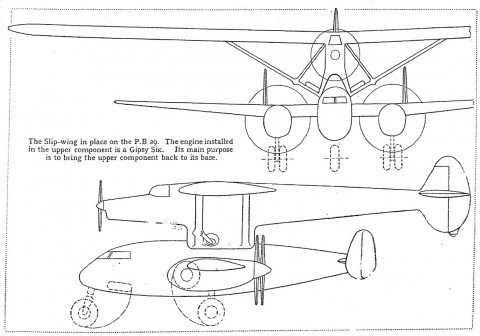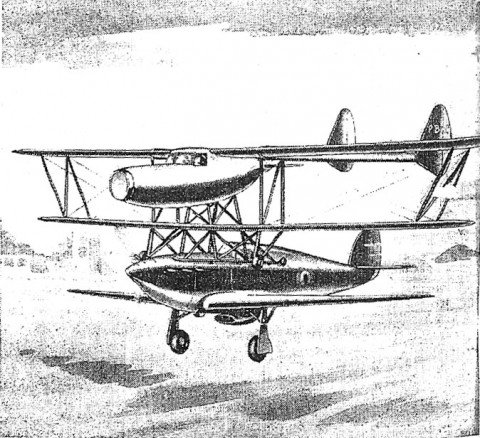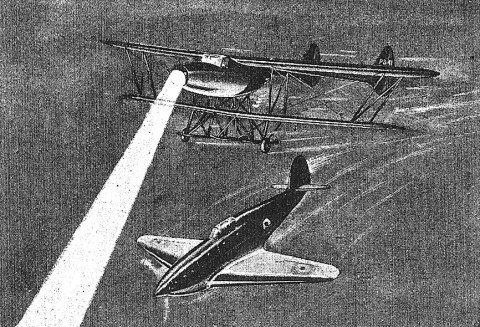At the end of October 1940, while the British and German air forces were nightly striking at each other's cities, Captain Norman Macmillan (a decorated RFC veteran and former head of the National League of Airmen) argued in Flight that Britain's greatest need was for the development of a bomber which was possessed great speed (400 mph), long range (5000 miles) and high bombload (5 tons), for
We may dominate the seas, but that to-day is not enough. We must dominate the land as well, and we do not do so. We shall not be able to dominate the land until we possess bombers which can reach out to the uttermost corners of the earth, from the bases we possess. And we cannot win this war until we are able to straddle the whole of Europe from the air.
That means range and speed.1
One man answered the challenge: Noel Pemberton-Billing, founder of Supermarine and sometime demagogic independent MP. He rejected the contemporary dogma of the self-defending flying fortress, which had proven a failure in daylight operations and so were forced to bomb less accurately at night. The only defence, he believed, was speed, not guns. His design -- the P.B.49, a twin-engine monoplane with a crew of three -- more than met Macmillan's specifications, and had the added virtues of being small and inexpensive.2 In fact, it was around the same size as the later Mosquito, and about as fast; but had more than twice the bombload at its maximum combat range of 8000 miles, itself more than five times the range of the wooden wonder. At shorter ranges, more bombs could be carried -- 10 tons per bomber to Berlin, for example. How was this incredible performance to be achieved? By slip-wing, of course.
Slip-wing aircraft have been discussed here before: they are composite aircraft, basically a form of assisted take-off which helps increase the performance (speed, endurance or payload) of one of the aircraft.3 In that thread I mentioned P-B's ideas for slip-wing fighters and bombers as described in his 1941 book Defence Against the Night Bomber; sadly it is not illustrated. So I was pleased to come across the series of illustrated articles he wrote for Flight in November and December 1940. The drawing at the top of the post is an artist's impression of a slip-wing bomber.4 Here, the spindly-looking biplane on top -- the slip-wing itself5 -- is used to help the bomber underneath to take off: not only does it provide an extra engine, but the two extra wings mean that the whole affair has plenty of lift so that it can get off the ground using a minimum of fuel. When the composite gets to operational height, the slip-wing detaches and flies back to base, while the bomber flies on to the target, without having used much of its precious fuel for take-off and climbing. (It's not quite clear in my scan, but the bomber is tractor-pusher combination. It's also somewhat Vampire-like.) However, this drawing was actually an earlier design; the P.B.49 plus slip-wing was only shown in plan form:6
The readers of Flight were quick to voice their objections. The most telling was that if by using a slip-wing you could launch a fast, high-performance bomber, then logically you could also use a slip-wing to launch a fast, high-performance fighter, and as it didn't need to carry bombs or have a long range, it could be made faster than the slip-wing bomber. P-B's answer7 was that fighters couldn't be at once fast AND manoeuvrable AND armed. Guns add weight, and produce drag, particularly for power turrets but even for wing-mounted guns. Manoeuvrability (says P-B) requires a wing loading of less than 30 lbs/sq. ft., and the more powerful the engine, the higher the wing loading (again, says P-B) -- but doubling the power does not double the speed. A slip-wing bomber would need neither guns nor manoeuvrability, and so could sacrifice fuel or bombload in order to increase speed to be faster than any given slip-wing fighter.
However, P-B did foresee a future for slip-wing fighters -- specifically, night fighters.8 This was a pressing concern at the time, for although Fighter Command had handily seen off the Luftwaffe's daylight raids, it had proven almost completely ineffective against night raids. The greatest difficulties lay in the detection and interception of the raiders. As detection was more or less a matter of chance at night, the defenders had to resort to standing patrols in the hope of catching something in their sights.9 Ideally, this entailed the use of twin-engine aircraft which could stay aloft for long durations, such as the Blenheim. But these were not much faster than the bombers they were intercepting, and so found it difficult to catch the enemy even when they were discovered. The slip-wing night fighter would, P-B proposed, solve all of these problems.
The duration and speed problems would be eliminated by using a slip-wing in combination with a high-performance single-seat interceptor -- a Hurricane would be ideal, because its sturdy steel frame would be able to handle having another aeroplane sitting on top of it. The composite would circle the night skies above London or wherever; the slip-wing's engine would do most of the work, or even all if it were sufficiently powerful. With the greater wing area comes greater economy, and in this way the endurance of the Hurricane could be, in effect, greatly increased. The crews of the upper and lower components could take turns in flying the composite, so that the others could rest or even sleep. And when an enemy bomber was sighted, the Hurricane would detach and swoop on its foe.
And this is how the enemy bomber would be sighted: the slip-wing would act as a flying searchlight! This is not quite as silly as it sounds. Flying searchlights were a popular topic in Flight's letter columns in late 1940, and the RAF did in fact try out the idea in the guise of Turbinlite, Havocs with 2.7 million candlepower searchlights in the nose,10 which would illuminate the targets in order for accompanying Hurricanes to shoot down. It didn't work because the Havocs were too heavy with the searchlights on board, and thus too slow. P-B's slip-wing night fighters would probably have had the same problem.
The Air Ministry was not much interested in slip-wings. They did supply a Hurricane to F. Hills and Sons in Manchester for experiments in what P-B termed 'scrap-wings', where a monoplane is turned into a biplane by adding an extra wing which increases lift; after take-off the extra wing is detached and falls to the ground. This became the F.H.40, which was never put into production. At least it made it into the prototype stage though, which is more than can be said for P-B's slip-wings -- a flying model of the P.B.29 was under construction at the time of writing, but I can't find any evidence of anything bigger. P-B blamed unimaginative civil servants for not pursuing his ideas, adding that though his aeronautical ideas had often been proved right in the past, it gave him little satisfaction
to realise that the design and policy I am now advocating, though in the opinion of their [the Air Ministry's] experts twenty years too soon, may be one year too late.11
Has a true slip-wing ever been built? P-B mentions precursors such as the Porte Baby/Scout combination and the Short Mayo composite. He didn't consider these true slip-wings, which carried their partners below them, not on top, it being much less efficient to launch an aeroplane up into the air than to drop one downwards. In the Second World War and after, various parasitic aircraft were evolved for specialised purposes, for example the B-29/X-1 combination, or the XF-85 Goblin parasite fighter, designed to be dropped from intercontinental bombers to protect them in enemy airspace. But generally, I think these don't fit either, because the parasites are small in comparison to their host aircraft and wouldn't affect the overall aerodynamics greatly (for the record, I am not an aerospace engineer!) Certainly they wouldn't have performed as effective biplanes.
The closest thing thing to a true P-B slip-wing may be this ungainly pairing:

Image source: Beige Alert.
Even here, however, the wings of SpaceShipOne may be too flush with and/or too staggered in from White Knight's to have the aerodynamics of a biplane. I think P-B would have liked it, though.
![]() This work is licensed under a Creative Commons Attribution-NonCommercial-NoDerivatives 4.0 International License.
Permissions beyond the scope of this license may be available at http://airminded.org/copyright/.
This work is licensed under a Creative Commons Attribution-NonCommercial-NoDerivatives 4.0 International License.
Permissions beyond the scope of this license may be available at http://airminded.org/copyright/.
- Norman Macmillan, "For the long-range bomber", Flight, 31 October 1940, 381. [↩]
- Noel Pemberton-Billing, "That long-range bomber", Flight, 14 November 1940, 413-5. [↩]
- Hence the title of this post, taken from a Flight editorial on P-B's slip-wing proposal, which in turn was taken from a much-filmed stage farce. [↩]
- This and the following image are from Noel Pemberton-Billing, "To whom it may concern", Flight, 21 November 1940, 429-32. [↩]
- Though sometimes P-B seems to mean the term to refer to the composite aircraft as well. [↩]
- The caption calls it the P.B.29 but this is contradicted by the text of the article and by Barbara Stoney, Twentieth Century Maverick: The Life of Noel Pemberton Billing (East Grinstead: Manor House Books, 2004), 237. The real P.B.29 was a quadruplane anti-Zepp fighter. [↩]
- Noel Pemberton-Billing, "The slip-wing fighter", Flight, 19 December 1940, 524-5. [↩]
- Noel Pemberton-Billing, "The slip-wing fighter", Flight, 26 December 1940, 550-2. The following two images are taken from this article. [↩]
- Before the perfection of airborne interception (AI) radar, that is. Radar was still most secret at this point in time, anyway. [↩]
- Wikipedia says billion, but I think this is wrong. [↩]
- Pemberton-Billing, "To whom it may concern", 432. [↩]





Paul Gilster
Brett, not the same concept, I realize, but didn't Focke-Wulf do some experiments with FW-190s and JU-88's in which the fighter was mounted above the bomber, the latter used as an unmanned flying bomb? I'm unaware, though, of any German efforts toward the slip-wing concepts the British were interested in. The Pemberton-Billing article was a real find!
Brett Holman
Post authorAh yes, Mistel -- good call! It's pretty close to a slip-wing in that it would be a biplane in aerodynamic terms, and the payload aircraft is slung underneath, not on top. I guess the main difference is in purpose -- the point of the pairing is not to boost the performance of one of the components but to act as a guidance/delivery system for a very big bomb.
There's a list of parasite aircraft concepts at Wikipedia and another at Nest of Dragons.
Les Whitehouse
The idea of a heavily loaded bomber or passenger aircraft getting off the ground with a lighter upper component which then detached (or vice versa) was not new.
It was patented by J. D. North of Boulton Paul Aircraft Ltd around the same time that Mayo patented his first ideas for the opposite, a large aircraft getting a smaller on into the air. North GB Pats Applications 34787/33, 28033/34 and 33023/34. Both Dornier and Junkers proposed much the same earlier in the 1920's, while wartime experiments proposed aircraft such as Fulmar above Whitley and Hurricane above B-24 for convoy protection.
Brett Holman
Post authorThanks, Les. The patent applications can be seen online: 34787/33, 28033/34 and 33023/34 (though only the first page of the PDF version seems to show up). It looks to me like North did consider the aerodynamic characteristics of the two aircraft as a whole, and maximised the characteristics of each for their particular purpose. So it does seem like P-B was not the first to have this idea. I wonder if he knew of North's patent? As an inventor it would have been his business to keep up with new patents, and he was just getting back into aeronautics at this time (1935). So he probably ought to have, but doesn't seem to have mentioned it.
Pingback:
Airminded · Future schemes of air defence